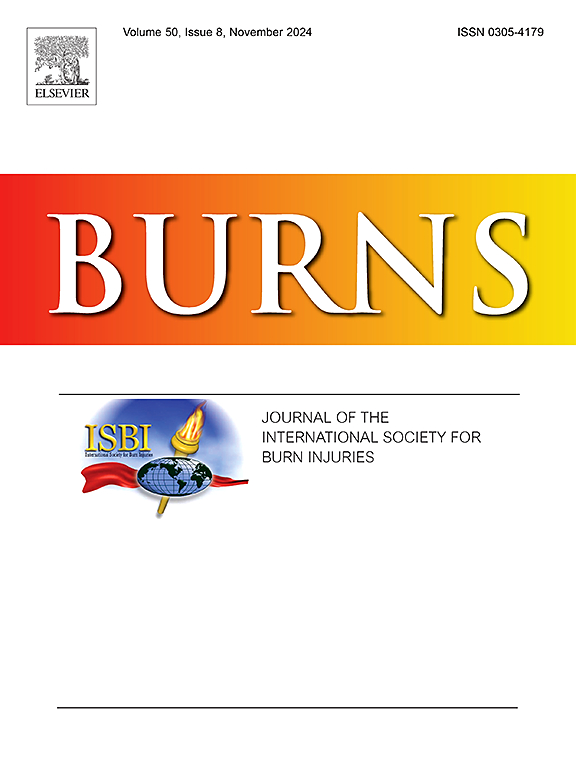成人烧伤患者康复的技术资源:范围综述
IF 2.9
3区 医学
Q2 CRITICAL CARE MEDICINE
引用次数: 0
摘要
研究创新技术以改善患者康复的重要性是当前医疗保健背景下的基础。这突出了需要绘制用于成人烧伤患者康复的技术资源。方法根据乔安娜布里格斯研究所(JBI)指南设置的参数进行范围评价,并使用PRISMA-ScR(系统评价首选报告项目和范围评价荟萃分析)进行结构化评价。科学文献检索涵盖了各种数据库:Medline, CINAHL, SportDiscus, Psychology &;行为科学合集,Scopus, SciELO和Cochrane图书馆。纳入标准考虑了与烧伤患者康复中技术资源使用相关的研究。这项研究一直持续到2024年11月。结果共纳入2000 ~ 2024年间发表的文献19篇。分析的技术资源包括虚拟现实(10项研究)、户外游戏(6项研究)、外骨骼(4项研究)和增强现实(1项研究)。这些资源主要旨在促进运动功能,增加肌肉力量,增强关节活动范围。结论该技术应用于烧伤患者的康复是一个有前途的进步,有可能改变康复的范式,使其更具互动性。未来的研究应侧重于对长期效益的详细分析,并将这些技术整合到标准的康复方案中。本文章由计算机程序翻译,如有差异,请以英文原文为准。
Technological resources in the rehabilitation of adult burn patients: A scoping review
Introduction
The importance of investigating innovative technologies to improve patient rehabilitation is fundamental in the current context of healthcare. This highlights the need to map the technological resources used in the rehabilitation of adult burn patients.
Methods
A scoping review was conducted according to the parameters set by the Joanna Briggs Institute (JBI) guidelines and structured using the PRISMA-ScR (Preferred Reporting Items for Systematic Reviews and Meta-Analyses for Scoping Reviews). The scientific literature search covered various databases: Medline, CINAHL, SportDiscus, Psychology & Behavioral Sciences Collection, Scopus, SciELO, and the Cochrane Library. The inclusion criteria considered studies related to the use of technological resources in the rehabilitation of burn patients. The research was conducted until November 2024.
Results
A total of 19 articles published between 2000 and 2024 were included. The technological resources analyzed included virtual reality (10 studies), exergames (6 studies), exoskeletons (4 studies), and augmented reality (1 study). These resources primarily aimed to promote motor functionality, increase muscle strength, and enhance joint range of motion.
Conclusion
The technologies applied to the rehabilitation of burn patients represent a promising advancement, with the potential to transform the paradigm of rehabilitation, making it more interactive. Future research should focus on a detailed analysis of the long-term benefits and on integrating these technologies into standard rehabilitation protocols.
求助全文
通过发布文献求助,成功后即可免费获取论文全文。
去求助
来源期刊

Burns
医学-皮肤病学
CiteScore
4.50
自引率
18.50%
发文量
304
审稿时长
72 days
期刊介绍:
Burns aims to foster the exchange of information among all engaged in preventing and treating the effects of burns. The journal focuses on clinical, scientific and social aspects of these injuries and covers the prevention of the injury, the epidemiology of such injuries and all aspects of treatment including development of new techniques and technologies and verification of existing ones. Regular features include clinical and scientific papers, state of the art reviews and descriptions of burn-care in practice.
Topics covered by Burns include: the effects of smoke on man and animals, their tissues and cells; the responses to and treatment of patients and animals with chemical injuries to the skin; the biological and clinical effects of cold injuries; surgical techniques which are, or may be relevant to the treatment of burned patients during the acute or reconstructive phase following injury; well controlled laboratory studies of the effectiveness of anti-microbial agents on infection and new materials on scarring and healing; inflammatory responses to injury, effectiveness of related agents and other compounds used to modify the physiological and cellular responses to the injury; experimental studies of burns and the outcome of burn wound healing; regenerative medicine concerning the skin.
 求助内容:
求助内容: 应助结果提醒方式:
应助结果提醒方式:


